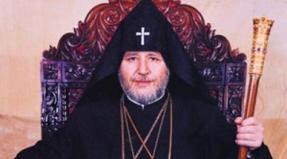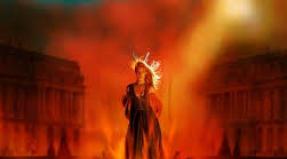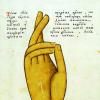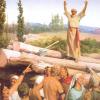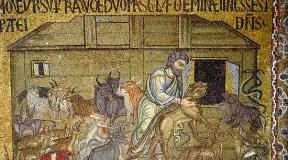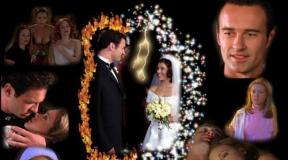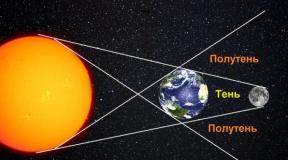New philosophy encyclopedia in 4 volumes. New philosophical encyclopedia - stepin
The New Philosophical Encyclopedia in 4 volumes was prepared by the Institute of Philosophy of the Russian Academy of Sciences and the National Social Science Foundation. This is the second domestic edition of this kind and scale.
The first was the "Philosophical Encyclopedia" in 5 volumes (M: Soviet Encyclopedia, 1960-1970), which included more than 4500 articles, which played a positive role and in some cases still retains its scientific value.
However, on the whole, it no longer meets modern requirements: first, because of the ideological preoccupation, which, as the publishers declared, was “to promote the widespread dissemination of Marxist-Leninist philosophy”; secondly, over the past 30 years, significant advances have been made in research work, new philosophical ideas, schools, names.
Compared to the creators of the 5-volume "Philosophical Encyclopedia", we have two happy advantages: we can use their experience and at the same time work in conditions of ideological looseness.
Our respect for the work of predecessors is expressed in the fact that we propose a different, re-performed systematization of philosophical knowledge (hence the name "New Philosophical Encyclopedia"), thereby emphasizing that the previous "Philosophical Encyclopedia" retains its (at least historical) significance.
New Encyclopedia of Philosophy - in 4 volumes - Ruk. project V. S. Stepin, G. Yu. Semigin
New philosophical encyclopedia: In 4 volumes / Institute of Philosophy RAS, Nat. general scientific fund;
Scientific ed. advice: head. V. S. Stepin, deputies head: A. A. Guseinov,
G. Yu. Semigin, uch. sec. A.P. Ogurtsov.-M .: Mysl, 2010
ISBN 978-2-244-01115-9
Volume-1 ISBN 978-2-244-01116-6
Volume-2 ISBN 978-2-244-01117-3
Volume-3 ISBN 978-2-244-01118-0
Volume 4 ISBN 978-2-244-01119-7
New Philosophical Encyclopedia - Ruk. project V.S.Stepin, G. Yu. Semigin - Postmodernism
POST-MODERNISM - trends that have manifested themselves in the cultural practice and self-awareness of the West over the past two decades. It is on the revision of the cardinal premises of the European cultural tradition associated with progress as the ideal and scheme of history, reason organizing around itself the entire knowable world, liberal values \u200b\u200bas a standard of socio-political arrangement, the economic task of a steady increase in material wealth. Such an overturning of the usual - "modernist" - representations (hence the term "postmodernism") covers a variety of areas of cultural activity, and if in the end. 1960s Postmodernism is associated mainly with architectural experiments based on a new image of space and style (Ch. Jenks and R. Venturi are considered the "classics" of postmodern architecture), then over time this term gains wider circulation, spreading to all areas of social life. In philosophy, this term is rooted by J.-F. Lyotard, who suggested talking about the "postmodern state", which is characterized by openness, the absence of female hierarchies, asymmetric opposition pairs (high-low, real-imaginary, subject-object, whole-part, inner-outer, surface-depth, East-West, male - female, etc.).
Postmodernism avoids "totalizing models" and is associated with a change in the cognitive paradagt, a revision of the subject's position as a center and source of the system of representations. The place of the subject is occupied by a variety of impersonal structures, be it flows of dimension (F Baudrillard), pulsations associated with libido (F Lacan), singularities (P. Virilio, J.-L. Nancy), irony (R. Rorty) or disgust ( Yu Kristeva). As a result, anthropocentrism, characteristic of the "modern", or enlightenment, picture of the world, is replaced by a multitude of ontologies, built in accordance with a multitude of "objects". A significant role in the development of these ideas was played by J. Derrida's “deconstructive” criticism of the “metaphysics of presence”. An attempt to comprehend the absence of a source, difference, and not identity as the starting point of thinking itself, leads Derrida and his associates to rethink the status of an event: the event ceases to be correlated with the universal truth of being. Foucault's analysis of subjectivity as a historical construct, as a peculiar function of power relations, cognitive practices and institutions that reinforce them, had a decisive influence on the formation of “subjectless” philosophy. The ideas about the “death of the author” (M. Foucault, R. Barthes, M. Blasho), expressing the historical exhaustion of both the phenomenon of authorship and the tradition of hermeneutic (“semantic”) interpretation of texts based on it, are also connected with this. Many concepts borrowed from the philosophy of postmodernism were transferred to literary criticism and "art criticism", having lost their original meaning and turned into a new "language of power." Postmodernism had a great influence on different kinds art, which is associated with a change in the status of a work of art in our time (the inevitable secondary nature of material and artistic gesture, a consciously implemented strategy of citation, pastiche, irony, play).
E. V. Petrovskaya
In postmodernism, a great role is played by the descriptive plan, that is, the characteristics of the newly emerged reality, and the polemical plan associated with the reassessment of the values \u200b\u200bof thought and culture. The whole reality eludes words and is denied by postmodernism. Only descriptions are accepted. These descriptions are constituted as the only reality. The author emphasizes those features of electronic culture that blur the distinction between truth and falsehood. Reality and fantasy merge in "virtual" reality, just like in Disneyland. The map precedes the territory and creates "territory", the television forms the society.
With the development of the culture of postmodernism, a kind of division of labor arose between America and France. The United States is the leader in the production of motion pictures, television programs, and computer games; France excels in comprehending and criticizing what is emerging. This criticism merges with anti-Americanism. America is dominated by the apologetics of "videooty": the most striking apologetic text belongs to Marshall McLuen.
French postmodernists (J. Baudrillard, P. Bourdieu, J. Derrida, M. Foucault, J. Lacan, J. Lyotard) attack the logocentrism of Western metaphysics, the "metaphysics of phonetic writing", the book culture of the New Age, which imposes a limited view of the world on a person. the relationship between knowledge and power, etc.
M. Foucault rejects the "naturalization" of Cartesian thought, the transformation of the laws of Aristotelian logic into the laws of nature, the pseudo-rational hegemony of thought of wealthy white men. Deviation from the norms was interpreted by the New Age as a disease, femininity as irrationality, colored skin as inferiority. Paphos Foucault is the defense of the “other”, the defense of the “plebs” who have become the object of subtle forms of violence.
Foucault's works cover many areas, but always focus on the problem of power, including sexual power. His theory of the body has become the most important source of modern feminism, continuing the analysis of Foucault. According to D. Butler, the binary concept of flooring is an artificial construction. Binary classifications (including the grammatical category of gender), explicitly or implicitly, regard masculine as the norm. According to feminist theory, hereditary heterosexuality and phallocentrism are understood as a system of power. This power is asserted by the language itself - it is phallocentric. Foucault also took up the idea that legal systems of power create subjects, which they then represent. Consequently, it is useless for women to seek emancipation from the political system that constitutes them as an object of manipulation and control. Male civilization must be destroyed to the ground. Behind these grotesque theories, however, are real shifts. Social movements take over the sphere of culture and much less - economic relations. Sexual minorities, ethnic groups, environmental activists, religious fundamentalists strive for different goals than the previous socialism. Many groups are psychologically traumatized and rebel against prevailing psychological norms.
Critics of postmodernism point out that this is a movement of the intellectual elite that does not affect the "silent majority." However, the “silent majority” simply does not see that the New Time is over and that a turn has begun in an unknown direction, an era of drift, loss and renewal of landmarks. Postmodernism has been compared to Alexandrian period antiquities. As then, epicureanism and skepticism prevail today. Like Pontius Pilate, postmodernism asks: "What is truth?", Being sure in advance that the one who will say: "I am truth" has not yet been born. However, there is a circumstance that undermines this historical analogy: the emergence and development of television. Some of the techniques of television (for example, collage) were first used in prose, in essays, in the plastic arts. Now we see the opposite influence of television on art. The technogenic civilization that created television has caused irreversible shifts in human outlook on the world. They were reflected by postmodernism. But all attempts to perpetuate the current state of the world, the current style of perception of life are unfounded.
The irresponsibility of television must be overcome. The destructive influence of television on private, political life, on culture was noted by K. Popper, G.-H. Gadamer and others. The history of culture is the history of harnessing new elements. Television provides tremendous opportunities for the integration of a modern person who is unable to achieve integrity in a society that is spontaneously moving towards separation and chaos. In modern culture, there is a reluctance to know where human society is heading. This escape from history leads to the idea of \u200b\u200bthe end of history, takes the form of art without "soil and fate", which has gone into the world of dreams and the free play of forms. The place of God, absolute, immortality is declared empty. All objects are perceived as if on the surface and are kept on the threshold of emptiness, clinging to each other. There is no hierarchy of depths, no hierarchy of the significant and the insignificant. The culture of postmodernism liberates Europeans from Eurocentrism, but at the same time liberates them from every center, from every focus in which the plurality of the world gathers. This shattered state of mind in the West takes on new meaning in Afro-Asian cultures. For the intellectuals of the "third world", the next deconstruction of yesterday's idols becomes the theoretical deconstruction of Western civilization as a whole. There is a temptation to assert their anti-Western culture-centricity, their national and confessional arrogance. Overcoming postmodernism requires a new spirit.
G. S. Pomerants
PERSON - a being best known to itself in its empirical factuality and most difficult to grasp in its essence. The way of being of a person in the Universe is so unique, and its structure is composed of such heterogeneous and contradictory elements, that it serves as an almost insurmountable obstacle to the development of any short, non-trivial and at the same time generally accepted definition of concepts such as “person”, “ nature of man, "" the essence of man, "etc. It is possible to distinguish at least four approaches to defining what a man is: 1) man in the natural taxonomy of animals, 2) man as a being, going beyond the living world and in the known at least opposed to him, 3) man in the sense of "human race" and, finally, 4) man as an individual, personality. As the centuries-old experience shows, at least three ways of answering the question of what a man is, what are his distinctive features, its differentia specifica. Conventionally, these methods can be designated as 1) descriptive, 2) attributive and 3) essential.
In the first case, researchers focus on the careful selection and description of all those morphological, physiological, behavioral and other characteristics that distinguish a person from representatives of all other species of living organisms, including from the nearest ones in the taxonomic series. This approach is implemented with particular rigor in natural-scientific (“physical”) anthropology, where the enumeration of the features that distinguish homo sapiens from all other representatives of the genus homo sometimes takes several pages and includes everything from the shape of the skull to the morphology of teeth and structure. lower and upper limbs. But sometimes, both for research and for popularizing purposes, especially in works on general issues of anthropogenesis, attempts are made to isolate cluster features, such as uprightness, large volume and complex structure of the brain, use and manufacture of tools and protection, developed speech and sociability, extraordinary plasticity of individual behavior, etc. But already in our time, faced with the real problem of the need to regulate experiments with a person (both for purely scientific and medical purposes), even natural scientists are forced to state as signs that define a person, and such , as its uniqueness in the Universe, the ability to think and make free choices, make moral judgments and thereby take responsibility for their actions.
The descriptive approach to the definition of man, which is also characteristic of philosophers, includes, for example, such signs as the biological inability of man, the non-specialization of his organs for a certain purely animal existence; special anatomical structure, extraordinary plasticity of his behavior; the ability to produce tools, make fire, use language. Only a person has a tradition, memory, higher emotions, the ability to think, affirm, deny, count, plan, draw, fantasize. Only he can know about his mortality, love in the true sense of the word, lie, promise, wonder, pray, sad, despise, be arrogant, arrogant, cry and laugh, have humor, be ironic, play a role, learn, objectify his plans and ideas, reproduce existing and create something new.
With the attributive approach, researchers try to go beyond the pure description of human traits and single out one among them that would be the main one, which would determine its difference from animals, and, possibly, would ultimately determine all the others. The most famous and widely accepted of these attributes is “rationality,” the definition of a thinking, intelligent person (homo sapiens). Another, no less well-known and popular attributive definition of a person - homo faber - as a creature predominantly acting, producing. The third, which deserves to be noted in this series, is the understanding of man as a symbolic being (homo symbolicus), creating symbols, the most important of which is the word (E. Cassirer). With the help of the word, he can communicate with other people and thereby make the processes of mental and practical assimilation of reality much more effective. One can also note the definition of man as a social being, on which Aristotle insisted in his time. There are other definitions, in all of them, of course, some very important, essential properties of a person are captured, but none of them turned out to be all-encompassing and, therefore, was never fixed as the basis for a developed and generally accepted concept of human nature. The essential definition of a person is an attempt to create such a concept. The entire history of philosophical thought is, to a large extent, a search for such a definition of the nature of man and the meaning of his existence in the world, which, on the one hand, would be fully consistent with empirical data on the properties of man, and on the other, would highlight the prospects for his development in the future. One of the oldest intuitions is the interpretation of man as a kind of key to unraveling the mysteries of the universe. This idea was reflected in Eastern and Western mythology, in ancient philosophy. Man at the early stages of development did not separate himself from the rest of nature, feeling his inextricable connection with the entire organic world. This finds its expression in anthropomorphism - the unconscious perception of the cosmos and deity as living beings, similar to man himself. In ancient mythology and philosophy, a person acts as a small world - a microcosm, and a “big” world - as a macrocosm. The idea of \u200b\u200btheir parallelism and isomorphism is one of the most ancient natural philosophical concepts (the cosmogonic mythologeme of "universal man" - purusha in the Vedas, the Scandinavian Ymir in the Edda, the Chinese Pan-Gu). Philosophers of antiquity see the uniqueness of man in the fact that he has a mind. In Christianity, the concept of a person as created in the image and likeness of God, having freedom in choosing good and evil, is born - about a person as a person. “Christianity freed man from the power of cosmic infinity” (N. A. Berdyaev). The Renaissance ideal of a person is associated with the search for his originality, with the assertion of his original individuality. An idea arises in the European mind humanism,glorification of man as the highest value. The tragedy of human existence is expressed in the formula of the herald of the post-Renaissance era B. Pascal "Man is a thinking reed." In the era of the Enlightenment, the idea of \u200b\u200bthe inexhaustible possibilities of an independent and intelligent person dominated. The cult of an autonomous person is the development of a personalistic line of European consciousness. At the center of German classical philosophy is the problem of human freedom as spiritual beingThe 19th century entered the history of philosophy as an anthropological age. In the writings of I. Kant, the idea of \u200b\u200bcreating philosophical anthropology. Criticism of panlogism was associated with the study of the biological nature of man. In romanticism, heightened attention arose to the subtlest nuances of human experiences, an awareness of the inexhaustible wealth of the world of the individual. A person is comprehended not only as a thinking, but above all as a leading and feeling creature. (A. Schopenhauer, S. Kierkegaard). F. Nietzsche calls man "an animal that has not yet been established." K. Marx connects the understanding of the essence of man with the social and historical conditions of his functioning and development, with his conscious activity, in the course of which man is both a prerequisite and a product of history. According to Marx's definition, “the essence of man ... in its reality is the totality of all public relations”. Emphasizing the importance of social ties and human characteristics, Marxists do not deny the specific qualities of a person endowed with character, will, abilities and passions, just as they take into account the complex interactions of social and biological factors. Individual and historical development of a person is the process of appropriation and reproduction of the socio-cultural experience of mankind. Marx's understanding of man was further developed in the 20th century. in the writings of representatives Frankfurt School, Russian philosophers. They revealed the features of the philosophical and anthropological concept of Marx, showing that for him the development of man is simultaneously a process of growing alienation: a person becomes a prisoner of those social institutions that he himself created.
Russian religious philosophy of the 19th and 20th centuries characterized by personalistic pathos in the understanding of a person (see: Berdyaev N.A. About the appointment of a person. M-, 1993). Neo-Kantian Cassirer treats man as a “symbolic animal”. Proceedings of M. Scheler, H. Plesner, A. Gehlen laid the foundation for philosophical anthropology as a special discipline. Concept unconscious determines the understanding of a person in psychoanalysis 3. Freud, analytical psychology CG Jung. The focus of existentialism is on questions of the meaning of life (guilt and responsibility, decision and choice, a person's attitude to his vocation and to death). personalism personality appears as a fundamental ontological category, in structuralism - as deposition in deep structures consciousness of the past centuries. W. Brüning in the work “Philosophical Anthropology. Historical background and current state "(1960; see in the book: Western Philosophy. Results of the Millennium. Yekaterinburg-Bishkek, 1997) identified the main groups of philosophical and anthropological concepts created over 2.5 thousand years of the existence of philosophical thought: 1) concepts, putting a person (his essence, nature) in dependence on predetermined objective orders - be it “essences” or “norms” (as in traditional metaphysical and religious teachings) or the laws of “reason” or “nature” (as in rationalism and naturalism) ; 2) the concept of man as an autonomous personality, divided subjects (in individualism, personalism and spiritualism, later in the philosophy of existentialism); 3) irrationalistic teachings about a person, dissolving him ultimately in the unconscious stream of life (philosophy of life and etc.); 4) restoration of forms and norms, at first - only as subjective and intersubjective (transcendental) establishments, then - again as objective structures (pragmatism, transcendentalism, objective idealism).
Strictly scientific research of man begins in the second half of the 19th century. In 1870 I. Teng wrote: “Science has finally reached man. Armed with precise and all-pervading instruments that have proven their amazing power over three centuries, she directed her experience precisely to the human soul. Human thinking in the process of development of its structure and content, its roots, endlessly deepened into history and its inner peaks, rising above the fullness of being - this is what has become its subject. " This process was extraordinarily stimulated by the theory of natural selection by Charles Darwin (1859), which had a great influence on the development of not only the doctrine of the origin of man (anthropogenesis), but also such branches of human studies as ethnography, archeology, psychology, etc. aspects or properties of a person that characterize him as an autonomous individual (or autonomous personality) or arising from his attitude to the natural world and the world of culture, which would not have been covered by special scientific research. A huge body of knowledge has been accumulated concerning all aspects of human life both as a biological and as a social being. Suffice it to say that everything related to human genetics is entirely the brainchild of the 20th century. Characteristic is the emergence of many sciences in the name of which the very word "anthropology" is present - cultural anthropology, social anthropology, political anthropology, poetic anthropology, etc. All this made it reasonable to raise the question of creating a unified science of man, the subject of which would be man in all properties and relationships, in all their connections with the external (both natural and social) world. As a working definition of a person, developed in domestic literature, such a unified science could proceed from the fact that a person is a subject of a socio-historical process, the development of material and spiritual culture on Earth, a biosocial being, genetically related to other forms of life, but isolated of them, due to the ability to produce tools of labor, possessing articulate speech and consciousness, moral qualities. In the process of creating a unified science of man, a tremendous amount of work remains to be done, not only to rethink the rich experience of philosophical anthropology, but also to search for the combination of these studies with the results of specific sciences in the 20th century. However, even in the perspective of its development, science is forced to stop at a number of mysteries the spiritual world a person, comprehended by other means, in particular with the help of art.
In view of the pressure threatening humanity global problems and a real anthropological catastrophe, the creation of a unified science of man appears today not only theoretically, but also practically the most important task. It is she who should reveal the possibility of realizing a truly humanistic ideal of the development of human society.
I. T. Frolov, V. G. Borzenkov
PHILOSOPHICAL ANTHROPOLOGY in broad sense words - a philosophical doctrine about man his "essence" and "nature"; in this sense, it covers a variety of philosophical trends insofar as these or other ways of understanding a person are presented within their framework, and permeates the entire history of philosophy.
Modern philosophical dictionary. - M., 1998.
ANTHROPOLOGY (PHILOSOPHICAL) - philosophy of man, highlighting as its subject the sphere of "properly human" being, human nature, human individuality, trying to explain through the anthropological principle both the man himself and the world, to understand a person both as a unique manifestation of “life in general” and as a creator of culture and history. During periods of "quiet development" of mankind and philosophy, a person comprehends himself as a part of the world, explains himself from another, objectifies himself. During periods of breakdowns and crises, when the image of both the world and the person collapses, the latter becomes a problem for itself and tries to understand itself from itself, through its own individuality, from its own completeness and integrity. The anthropological question "What is a man?" Becomes the main question of philosophy. If "periods of withdrawal" each time put and formulate the problem of a person in a new way, then "periods of calm development" build intuitions about a person into conceptual pictures of the world. Philosophical A., being an independent direction, makes expansive intrusions into the spheres of existentialism, hermeneutics, phenomenology, personalism, pragmatism, cultural studies, and other ontological and epistemological directions, trying to highlight the sphere of "the human being proper."
Philosophical A. was prepared by the centuries-old development of philosophical thought, various versions of the concepts of man. But its design as an independent philosophical direction began with the philosophy of L. Feuerbach, and was finally determined in the 20s. XX century. in German philosophy in the concepts of M. Scheler, H. Plesner, A. Gehlen, M. Buber and others.
The programmatic works within the framework of A. were: "The position of man in space" M. Scheler (1928), "The steps of the organic and man" H. Plesner. It is believed that the lack of development determined the new branch of life that began with a person. Man is "a being determined by his shortcomings" (Gehlen). Portman speaks of the person as a "normalized baby". A person is characterized by "non-specialized organs", the absence of "instinctive filters" (Gehlen), insecurity from the pressure of the environment. As a result of such insecurity, openness to the world becomes the leading principle of communication with the environment. A special position of a person appears in relation not just to the environment, but to the world. He is the only creature able to adapt to any environment, moreover, to move from one environment to another (Gehlen), able to become "above the world" (Scheler), to take an eccentric position (Plesner). The organic lack of equipment is compensated by the spirit - the out-of-life principle. Man is a meeting place and intersection of spirit and life (Sheler). In addition, as a result of biological non-specialization, a special practical intellect was formed in man, with the help of tool activity he began to adapt nature to himself, create his own environment for his habitation - the world of culture, making it the natural basis of his life (Gehlen). The openness of the world, a special eccentric position, forcing a person to seek the center of his existence outside himself, dooming him to eternal search, wandering, eternal striving for self-improvement, makes a person a multidimensional being, in need of many “others”, “other”, “not-me”, "you". Human spirituality presupposes communication, connection with people, a community of "we".
So, biological insufficiency presupposes active activity, connection with the world, with other people, spirituality, embodiment in culture. From this point of view, culture itself is understood as a necessary product of the human instinctual and vital sphere. Human ethics, law, and social institutions are derived from the instinctive-vital foundations. "Natural law" must take into account the instincts of aggressiveness (which underlie both male sexuality and social conflicts and the will to power), and the instincts of reciprocity (this is the basis of communication, peace, justice, etc.), and other innate human inclinations ... Social institutions are built in accordance with semi-instinctive forms of behavior and should, taking into account the biopsychic nature of a person, gently regulate life, based on the principle of life well-being. So, culture, state, social institutions follow from the biological basis of man and serve it as well. The Austrian ethologist and anthropologist K. Lorenz also speaks from similar positions.
Biologized morality also turns out to be social-institutional. Institutions provide stable norms of community life and make up for the lack of instinctive equipment of a person. By limiting the capabilities of an individual, institutions provide mutual support, provide relief that leads to stability, to mobile freedom, but within the framework of a certain structure. Since institutions have a bioanthropological basis, one should be very careful with them, not destroy them, not invent new ones. Disregard for institutions is dangerous, today there are no cultural constraints, and violence can take its most rampant forms. The cultural trend in Armenia focuses on the cultural foundations of man. Representatives of this trend are, for example, M. Landman, E. Rothacker. Their works date back to the 50-60s. XX century. For them, man is a creator and a creation of culture. Due to non-specialization, a person is forced to create his own world, which he then narrows down to the level of the "environment" - a meaning-filled, linguistic environment into which he is embedded, grows in. The world of the Greek is not at all similar to the world of the Anglo-Saxon, the tree in the world of the lumberjack is not similar to the tree in the fairy-tale world of a child. The world is an interpreted, meaningful, valuable environment of a person. This is its environment, from which it cannot be painlessly torn away. The cultural environment is a certain spiritual landscape. Each culture has its own cultural threshold, allowing only that which matters within a given lifestyle. The human environment differs from the animal environment and the fact that in the animal world the inhabitant of the environment is a species, in humans it is a special group (professional, social, ethnic). Everything that does not belong to one's own cultural sphere is perceived as alien, threatening, dangerous, inhuman. Rothacker proceeds from culture as a vital-existential a priori; the environment is experienced in an existential way, sets the lifestyle of a person. The human world is the world of symbolic connections with reality, the world of phenomena that a person has highlighted as a searchlight for his vital interests and isolated from the mysterious reality. Landman, refusing to consider the process of anthropogenesis, immediately proceeds from a person as from a matured wholeness. He emphasizes that both man and animal live from their own foundations, from which they should be understood. Spirituality is the true beginning of a person: the spirit forms the body of a person and his entire being. Man is a product and a weapon of the spirit, he is shaped by culture and forms it himself. Landman objectifies spirit by viewing human subjectivity as the point of condensation and detection of the objective spirit.
The religious-philosophical direction of A. (G.E. Hengstenberg, I. Lotto, F. Hammer, M. Buber) considers the problem of man through the religious-Christian principles of understanding the world, God, the connection of spirit, soul, body, etc. God created the world and a person. Man was created on a separate day, thus he was given a special - higher - place in the world, he is the crown of creation, the lord of all that exists. Man is created in the image and likeness of God. But if, with t. Sp. the world, man is the supreme being, the crown of creation, then, with t. sp. God, he is only a shadow of God, he is insignificant before God, sinful. Through sin he opened himself to freedom, knowledge, morality, and this was due to himself, and not to God. Through sin man comprehends his divine nature, through overcoming sin he goes to the divine in himself. The human soul is from God, it is pure, through the path of faith, the soul leads a person to salvation. Each individual is responsible for himself before God. Man as a godlike creature with the help of the spirit rises above the world, can contemplate it, treat it objectively. Hengstenberg asserts as the main thesis of A. the principle of human objectivity - “an appeal to an object for the sake of his own self, free from considerations of benefit. Such an appeal to an object can be realized in cases of contemplative comprehension, practical action or emotional assessment. " This is an attitude that presupposes the meeting of one's being and the being of the world. A person, deprived of "objectivity", cannot love, recognize the intrinsic value - both his own and the other. The highest manifestation of objectivity is love, and especially love for God. Love is joy and gratitude that the external object of our relationship is and that it is as it is. Objectivity manifests itself in concrete human actions, it is an expression of transcendental expediency, in accordance with which human life activity is formed. The ontological principle of objectivity is spirit. The vital sphere is opposed to the spirit, but it not only opposes the spirit, it also connects the spirit with the physical-bodily foundations through the vital-psychic foundations. The human body serves as the expression of the spirit, it is the "metaphysical word of the spirit." And if Gehlen approached a person with an inhuman animal measure, then Hengstenberg - with an inhuman divine-spiritual one.
Loving openness to the world, to God, to man is taken for the essence of man and his connection with another M. Buber and F. Hammer. This attitude is realized in the "I - you" dialogue. In this respect, people give themselves to others, while continuing to be themselves. This form of communication is fundamentally opposed to the relationship "I - it". It is the connection "I - you" that is the condition for true "humanity". “The basic word“ I - you ”can only be said with all of your being. The basic word "I - it" can never be said with the whole being. The “I - you” relationship is realized in life with nature, people and spiritual beings ”(M. Buber). When speaking with each “you,” a person speaks with the eternal You, with God. At the same time, a specific person, tree or stone that says “you” stands out from a number of objects, becomes exclusive, incomparable and at the same time absolute, “fills the firmament with itself”, everything else “lives in its light” - “here is the cradle of true life”, this is a meeting, love. The relationship "I - you" expresses the essence of a person, his connection with another, but this relationship is unstable, it falls into an objectifying, using, dismembering relationship "I - it ”, which captures only the edge of true life. Both the world and man are twofold in accordance with the duality of man's position. "I" is formed thanks to "you", it is determined through "I". “You” “falls” into the sphere of alienation, into “it”, which, however, through entering the event, the relation turns into “you”. “A person cannot live without 'it'. But the one who lives only with "it" is not a person. " The relationship "I - you" is a revelation, an elevation to the image of God. "But revelation is not poured into the world through the one who perceives it as through a funnel: it takes place in it, it captures all its elements."
A. found its development in a rich variety of teachings and concepts: V. Brüning, O. F. Bolnov, A. Gehlen, E. Rothacker, G. E. Hengstenberg, A. Portman, M. Landman, K. Lorenz, K. Levi-Strauss, P. Ricoeur, and others. It was divided into biological, religious, cultural, psychological, structuralist, pedagogical A. The ideological origins of A. were, on the one hand, the philosophy of life (Schopenhauer, A. Bergson, F. Nietzsche), and on the other - concrete biological and psychophysiological discoveries and concepts (L. Bolk, P. Teilhard Chardin, 3. Freud, J. Ixskul). According to M. Scheler, philosophical A. should combine the concrete scientific, philosophical and religious comprehension of man. The image of a person, broken into thousands of small pieces, must be put together.
Biological and anthropological direction (M. Scheler, A. Portman, H. Plesner, A. Gehlen) notes that, from a biological point of view, a person turns out to be a "sick animal", "an insufficient creature", "a false step in life", "Dead end of life", "deserter of life", "the only being able to say no to life", "ascetic of life", "unfinished being." The natural science basis for such conclusions was, in particular, the idea of \u200b\u200bretardation (slowness, developmental delay) by L. Bolka. Its essence is that, as a result of disruption of the endocrine system, an adult is anatomically and physiologically similar to the embryo and fetus of an anthropomorphic monkey, that is, a person is a sexually mature embryo of a monkey. In man, we are faced with the "decadence of life", with its decline. According to M. Scheler, "a person can always be only something less or more than an animal, but an animal - never." So, philosophical A., through a variety of approaches and directions, tries to understand what a person is in his self and at the same time completeness and integrity. The answers to this question can come from biological foundations (Portman, Lorenz), from socio-biological (Gehlen), from a dialogical relationship (Buber), from the divine principle (Lotz, Hengstenberg), from several grounds at the same time (Scheler). But, as anthropologists themselves note, in the series of intuition about a person, only one clearing has been cut through, the same task remains - to create an integral concept of a person. In our time, this problem is solved through an appeal to existentialism (O. F. Bolnov), to the fundamental ontology of M. Heidegger, to hermeneutics (P. Ricoeur), to linguistic structures, to postmodernism. At the same time, the methodological guidelines for constructing A. are extremely important, put forward, in particular, by H. Plesner in his work "Zwischen Philosophie und Gesellschaft" (1953): 1. It is necessary to agree with any aspect that can rise to the level of the claim of revealing the human essence, whether physical, mental, spiritual-practical or religious aspects; they must be recognized as equally valuable. 2. The initial basis, allowing the transition from one aspect to another, must be rooted in the historical place of a person, from which a person learns himself. 3. If it seems that everything about a person is known, that everything has already been said about him, then it should be remembered that this is just an approximate and inconclusive knowledge and it cannot be the last truth.
L. A. Myasnikova
The task:
Based on the above encyclopedic articles "Man" and "Philosophical Anthropology" answer to next questions:
1. How do you understand what the human problem is?
2. How does a human problem manifest itself in the modern world?
3. What are the main approaches to defining the essence of a person? List them and characterize each approach. Give examples.
4. Name three ways of answering the question, what is a person. Describe each method.
5. What is philosophical anthropology?
6. What is the main question of philosophical anthropology?
7. Which philosopher stands at the origins of philosophical anthropology?
8. What is the peculiarity of human existence in comparison with representatives of the animal world?
9. What is the special position of man in relation to the world?
10. Why is the cultural environment a certain spiritual landscape?
11. How is a person understood in a religious and philosophical direction?
12. Why in the biological and anthropological direction a person is understood as an “insufficient creature”?
INSTITUTE OF PHILOSOPHY OF THE RUSSIAN ACADEMY OF SCIENCES
NATIONAL SOCIAL SCIENTIFIC FOUNDATION
PHILOSOPHICAL
ENCYCLOPEDIA
IN FOUR VOLUMES
NEW
PHILOSOPHICAL
ENCYCLOPEDIA
IN FOUR VOLUMES
SCIENTIFIC EDITORIAL BOARD
ACADEMICIAN OF THE RAS V. S. S TEP I Η - CHAIRMAN OF THE BOARD CORRESPONDING MEMBER OF THE RAS A.A. Huseynov -VICE-CHAIRMAN
doctor of Political Science G.Yu.SEMIGIN - Deputy Chairman Doctor of Philosophical Sciences A. P. OGURTSOV -Scientific Secretary
PROJECT MANAGERS V.S. STEPIN, G.Y. SEMIGIN
\\\\ 72Ζ
(!? 0)1 "Ai ..-: srï «: · i: ici 8ô H
PHILOSOPHER KAYA
ENCYCLOPEDIA
VOLUME THIRD
MOSCOW "THOUGHT" 2001
UDC 1 (031)
BBK 87ya2
Scientific experts
R. G. APRESYAN, Dr. oilos. sciences (ethics) V. V. BYCHKOV, doctor Philos. sciences (aesthetics) i, 4
P. P. GAYDENKO, CORRESPONDING MEMBER OF RAS (ONTOLOGY)
M. N. GROMOV, Dr. Philos. Sciences (Russian Philosophy) T. B. Dlugach, Dr. Philos. Sciences (Western Philosophy)\u003e, A. A. KARA-MURZA, Dr. Philos. Science-political Philosophy)
: "V. A, LEKTORSKY, CORRESPONDING MEMBER OF THE RAS (THEORY OF KNOWLEDGE) L. N. MITROKHIN, ACADEMICIAN OF THE RAS (PHILOSOPHY OF RELIGION)
N. V. MOTROSHILOVA, Dr. Philos. Sciences (history of Philosophy)
A. S. PANARIN, Dr. Philos. Sciences (Social Philosophy "
V. A. PODOROGA, Dr. Philos. Sciences (philosophical anthropology)
IN. Η. Π OSU S, CANDIDATE PHILOS. SCIENCES (THEORY OF KNOWLEDGE)
M. A. Rozov, Dr. Philos. sciences (theory of knowledge)
A. M. RUTKEVICH, Dr. Philos. Sciences (Western Philosophy 19-20 centuries)
E. D. SMIRNOVA, Dr. Philos. sciences (logic)
M. T. STEPANYANTS, Dr. Philos. Sciences (Eastern Philosophies)
V. I. TOLSTYKH, Dr. Philos. Sciences (Philosophy of Culture)
B. G. YUDIN, CORRESPONDING MEMBER OF RAS (PHILOSOPHY OF SCIENCE AND TECHNOLOGY)
Scientific editors
M. S. KOVALEVA, E. I. LAKIREVA, L. V. LITVINOVA, M. M. NOVOSELOV, Dr. Philos. Sci., A. P. POLYAKOV, Y. N. POPOV, A. K. RYABOV, V. M. SMOLKIN
Scientific support work
L. N. ALISOVA, doctor polit. sciences (head); V. S. BAEV; L. S. DAVYDOVA, candidate ist. sciences; IN. D. BEACH, candidate jur. sciences; N. N. RUMYANTSEVA, Ph.D. Econ. sciences
PUBLISHED BY THE RVDACTION OF THE INSTITUTE OF PHILOSOPHY OF THE RAS
ISBN 5-244-00961-3 ISBN 5-244-00964-8
Institute of Philosophy RAS. 2001
National Social Science Foundation. 2001
00.htm - glava01
Η
NABER (Nabert) Jean (June 27, 1881, Iso, Dauphiné - October 14, 1960, Loctudy, Brittany) - French philosopher. He received his philosophical education at the University of Lyons, since 1926 - a doctor of philosophy, in 1931-41 he taught at the Lycée Henri IV (at the department of preparation for the competition at the Ecole Normal); in 1944 he was appointed inspector general of philosophy, then director of the V. Cousin Library. Naber continues the tradition of the reflective philosophy of Descartes, Kant, Maine de Biran and Fichte; was influenced by the ethical teachings of Bergson, Lanjo and Brunswick.
In Naber's concept, the substantiation of the inner freedom of the individual and the creation of a system of ethical values \u200b\u200bare based on the Cartesian proposition that the individual's awareness of himself as a thinking subject is the initial principle of philosophizing. Naber's reflexive method presupposes the implementation of philosophical analysis in two opposite directions: on the one hand, an appeal to the personal moral experience of a person, on the other, going beyond the limits of the individual's consciousness and considering what is behind it. Accordingly, this method is based on two principles - self-affirmation ("I is ") and transcending. According to Naber, reflection implies intersubjectivity, is transcendental (not empirical) in nature and pursues a practical goal - the transformation of a person's worldview and behavior.
An analysis of the individual experience of the reflective subject (initial feelings of guilt, collapse and loneliness) of the data of moral consciousness, the results of interaction with the world and interpersonal communication allows Naber to draw a conclusion about a person's ability to moral freedom, his inherent desire to transcend, constituting himself as a moral subject, about the presence of an unavoidable need for ethical values \u200b\u200band the idea of \u200b\u200bthe absolute.
Soch.: L "Expérience intérieure de la liberté. P., 1924; Eléments pour une éthique. P., 1943; Essai sur le mal. P., 1955; Le Désir de Dieu. P., 1966.
Lit.: La philosophie religieuse de Jean Nabert. Namur, 1974; Evert P. Jean Nabert oul "Exigence absolue. P. 1971; Naulin P. L "Itinéraire de la conscience. Etude de la philosophie de Jean Nabert. P., 1963; Le problème de Dieu dans philosophie de Jean Nabert. Clermont-Ferrand, 1980; RicoeiirP. L "acte et le signe selon J. Nabert. -" Etudes philosophiques ", 1962, N 3.
O. I. Machulskaya
OBSERVABILITY PRINCIPLE - a methodological requirement imposed on a scientific theory, according to which the theory should have an empirical substantiation of its initial premises and significant logical consequences from them. Although the term "observability principle" became generally used only in the 20th century, during the years of the construction of the theory of relativity and quantum mechanics, the very requirement to follow the principle of agreement of theory with observations was clearly also in classical science. Galileo has already formulated
he established such a criterion for the acceptability of theoretical definitions: "The definition ... seems to us to be trustworthy mainly on the basis that the results of experiments perceived by our senses are fully consistent with the properties derived from it" (Galileo G. Selected Works, vol. II. M., 1964, p. 239). Objections related to the adoption of the Copernican system, according to which the Sun rests in the center of the planetary world, and does not move along the firmament, as we observe every day, are rejected by Galileo by distinguishing between the concepts of visibility and reality. Visibility is direct observation of individual phenomena, while reality is a system of observation results, interconnected and interpreted through theory. Newton believed that direct observation has greater weight in comparison with theoretical constructions. In one of his letters, he stated: “It seems to me that the best and most correct method in philosophy is to first carefully investigate the properties of things and then gradually move on to hypotheses to explain them. For hypotheses are useful only for explaining the properties of things, and not for determining their properties, at least since properties can be established by experiments " (Newton I. Optics. M., 1954, p. 320). Newton's requirement to rely in scientific knowledge on an experimental basis can be understood as a requirement to follow the principle of observability in the broad sense of the word. Classical science presented a wide range of interpretation of the principle of observability - from the experimental substantiation of each element of the theory to the requirement of experimental verification of only the consequences of theoretical constructions.
In the first publications on the theory of relativity, Einstein emphasized the need for an observational definition of the basic concepts of the theory. The time of the event is the indication of the resting clock, which is at the place of the event, simultaneously with the event. “How long is this rod? This question can have only one meaning: what operations should we do to find out what the length of the rod is. " (Einstein A. Collection of scientific papers, vol. 1. M., 1965, p. 182). Later, Einstein was forced to move away from a rigid interpretation of the principle of observability, which was associated with the evolution of his methodological views ~ from an open recognition of empiricism, he gradually moved to what later received the name of rational realism. In this regard, he began to talk about indirect observability, insisting that the theoretical basis of physics "is increasingly moving away from the data of experience, and the mental path from the foundations to the theorems arising from them, correlating with sensory experiences, becomes more and more difficult and long" ( ibid, v. 4, p. 226).
The formation of quantum mechanics was associated with the explicit impact of the principle of observability. W. Heisenberg's work on matrix mechanics begins with the statement:
OBSERVER
commercial mechanics, based solely on the relationships between quantities that are principally observable " (Heisenberg W. Über quantentheoretische Umdeutung kinematischerund Bezie hungen. - "Zeitschrift für Physik", 1925, Bd 33, S. 879). Many physicists and philosophers reacted strongly to Heisenberg's position to attach decisive importance to the principle of observability. So, for Einstein, this was a reason to reject the methodological attitude, which he himself once shared. Opposing Heisenberg, Einstein put it this way: "Only theory decides what exactly can be observed." (Heisenberg V. Quantum Mechanics and Conversation with Einstein.- "Priroda", 1972, no. 5, p. 87).
At the same time, during the formation of physical theories of the 20th century. their creators themselves emphasized the methodological significance of the observability principle. The fact is that in the process of the birth of new theoretical constructions, it is not just some separate methodological principle that operates, but their system. Sometimes a scientist pays special attention to one of them, leaving out of consideration other principles that act implicitly, but nevertheless determine the process of the formation of a scientific theory.
Η. Φ. Ovchinnikov
OBSERVER (in philosophy of science) - researcher, leading observation behind the object under study. Sometimes observation is carried out directly with the help of the senses - sight, hearing, tactile (tactile) perception. Butoften it is required to equip the observer with instruments - a microscope, telescope, synchrophasotron, locator, etc. The concept of an observer and his relationship with the object of observation and with the device with which the object is observed has acquired special significance in quantum theory. Difficulties in cognizing micro-objects - elementary particles - forced us to turn to the classical philosophical problem of the relationship between a subject - an observer-object (subject of research). In quantum physics, the cognizing subject is forced to observe the object by means of a macro device. As a result, our knowledge about the behavior of objects in the microcosm can be expressed in the form of macroscopic concepts. In the classical theory that studies the behavior of macroobjects, it is assumed that the state of a particle can be characterized by its exact position in space (coordinate), its mass and velocity (momentum). In quantum theory, the coordinate and momentum of a particle are complementary. If the exact position of the particle is known, then the concept of the exact value of its momentum is inapplicable to it; if it is known exact value momentum, then the concept of exact position is not applicable to the particle. The nonclassical nature of the situation can also be expressed in the following way: according to quantum theory, such an experiment is fundamentally impossible as a result of which it would be possible to simultaneously obtain an exact knowledge of the position of a particle and its momentum. This provision has the character of a prohibition: it is completely analogous to the principle according to which it is impossible to build a perpetual motion machine of the first kind, extracting energy “from nothing”. The prohibition of observing the simultaneous value of the coordinate and momentum has its basis in the atomism of interaction, while interaction is an inevitable element of any scientific observation.
K. F. Ovchinnikov
OBSERVATION - deliberate and purposeful perception, due to the task of the activity. Historically, observation has developed as an integral part of the labor force.
an operation that includes establishing the conformity of the product of labor to its planned ideal image. With the increasing complexity of social reality and labor operations, observation is distinguished into a relatively independent aspect of activity (scientific observation, perception of information on devices, observation as part of the process artistic creation etc.). Scientific observation implies awareness of goals and is based on a system of observation methods that allow to achieve objectivity and ensure the possibility of control through either repeated observation or the use of other research methods, for example. experiment (at the same time, observation is usually included as an integral part of the experimental procedure). To the fore in modern science more and more interpretation of the results of observation appears.
NAVSIFAN (Ναυσιφάνης) from Theos (late 4th century BC) - Greek philosopher, partaking in the traditions of atomism and skepticism. Follower Democritus (through the student of Democritus Metrodore of Chios and his successors - Diogenes of Smyrna and Anaxarchus), listener Pyrroyaa and teacher Epicurus. The author of "Tripodius", which expounded ethics, physics and logic, is the likely source of Epicurus's "Canon" (opinion of the biographer of Epicurus Ariston, referred to by Diogenes Laertius, Χ 14). Ethics attributed to Navsifan the introduction of the term "imperturbability" (άκαταπληξία) (fr.3 \u003d Clem. Strom. II, 21.130) instead of the Democritian "fearlessness" (άθαμβίη) - cf. epicurean equanimity (ataraxia). Navsifan's interests also included mathematics, music, and rhetoric. Navsifan's views on rhetoric are critically discussed in the treatise Philodema kz Gaiara "On rhetoric", book. 6. About Navsiphanes as the teacher of Epicurus speaks Apollodorus in the "Chronology", Clement of Alexandria in the "Stromats" (Strom. I, 14, 64), as well as the dictionary of the Court; however, the tradition going back to the testimony of Epicurus himself denied this discipleship (see D / o ^. £. Χ 13,15). fragment: DK II, 246-250.
M. A. Solopova
NAVIA-NYAYA (Saxon navya-nyaya) is a school of logic that emerged in India in the 13th century. within the framework of the religious and philosophical direction nyaya and existed until the second half of the 17th century. The founder of the school - Gangesha. The main text of the navya-nayaiks, on which they wrote commentaries, was the Tattva-cintamani by Gangesha, who called his teaching the "new" nyaya, in contrast to the "old" tradition, which comes from the "Nyaya-sutras" of Gautama-Akshapada. The Tattva-cintamani examines the problems of epistemology (the structure of the text is based on the four sources of reliable knowledge accepted in nyaya - perception, inference, comparison and verbal evidence of authority) and the philosophy of grammar. The new methods of logical analysis of reasoning created by the Gangesh were further improved by Raghunatha Shiromani (c. 1475-1550). The school also included Jayadeva (Mishra) Pakshadhara (1425-1550), Mathuranatha Tarkavagisha (c. 1600-75), Jagadisha (16th century), Laugaksha Bhaskara (c. 1590) and Annambhatta (17th century), who contributed "clarification terminology and formalization of logic.
Gangesha in "Tatgwa-cintamani" after critical examination rejected 21 well-known definitions vyayati ("Relations of penetration" of the terms of inference) and offered his own four. The school also developed concepts of other types of logical relations, in particular, relations of con-
==6
VISIBILITY
tact (samyoga), inherent possession (samavaya) and species relation (svarupa-sambandha) - the latter two resemble the relation of class and its element in mathematical logic and predication in Aristotle. A branch of the theory of Navya-Nayaik relations is the concept of "paryapti-sambandha" - a relationship through which the number resides in whole objects, and not in parts of a whole. This concept is reminiscent of the Western logic view of number as a class of classes. The Navya-nayyaki also discussed and developed the concept of absence (abhava), specifiers-determinants, abstract properties, pairwise "detectors" - "discoverable" and limiters, proposed a detailed theory of definitions. The peculiarities of Sanskrit, which makes it possible to write logical expressions in one term and then combine these terms in reasoning, allowed the Navya-Nyaya logicians, earlier than in Aristotelian logic, to pose and solve some problems, in particular, they understood the truth-functional nature of the logical connectives "and" and " or ”and used (although not explicitly formulated) de Morgan's law. In the 17th century. Navya Nayliks move away from epistemology and grammar problems, focusing on formal logical problems.
Lit .:IngallsD. G. X. An introduction to Indian logic Navya-nyaya. M., 1974.
ff. A. Kanaea
NAGARJUNA (Skt. Naga-arjuna - Snake-tree) (150 BC - 250) - the founder madhytikas, the author of its basic texts. Numbered among enlightened beings, or bodhisattvam, Mahayana and perfect sorcerers, or siddhas, Vajrayana. About Nagarjuna is known only from hagiographic sources describing him as a supernatural being, whose life lasted from 400 to 600 years in exploits for the glory of the Mahayana. Perhaps he was of a Brahmin family from South India, a master of philosophical polemics and meditation, the creator of more than a dozen religious and logical-dialectical works, although about 200 works attributed to him have survived in Chinese and Tibetan translations: from commentaries on Buddhist sutras to manuals on alchemy, physicians , metallurgy, etc.
In scientific Buddhism, Nagarjuna is considered to be the author *. Madhyamika-kariki " and doctrinally related treatises, in which the ideas of the early Mahayana were commented on and defended in polemics. In these texts (some of them have come down to us in Sanskrit), various approaches were used, including the method of negative dialectics, to convey the indescribability of the non-dual Absolute through separate Madhyamik teachings: about the identity of nirvana and samsara, about emptiness, about the absence of general relativity and interdependence of an independent entity, about two truths - conditional and unconditional, about two bodies of Buddha, about the dual practice of Enlightenment - through the accumulation of morality (punya) and intuitive yogic knowledge (jnana), etc. Nagarjuna's works were studied and commented on in throughout the period of Indian Buddhism, this tradition continues to this day in Tibeto-Mongol-Russian and to a certain extent in Sino-Japanese Buddhism.
Lit .: Androsov V.P. Nagarjuna and his teachings. M., 1990; Lamotle É. Le Trailé de la grande vertu de saggesse de Nagaijuna (Mahaprana-pâramitasliastra), t. 1-5. Louvain, 1944-80; Ramanaii K. V. Nâgarjuna's Philosophy, Delhi, 1978; Undiner Ch. N.igaijunia.u. Studies in the Writings and Philosophy of Nagarjuna. Cpli. 1982; Tolu F., DragoriettiC. On Voidness. A siudy on Buddhist Nigilisni. Deil "ii, 1995.
V.P. Androsov
NOG (Nagel) Ernst (November 16, 1901, Nove Mesto, Czech Republic - September 20, 1985, New York) - American philosopher, representative of naturalism. Graduated from Columbia University, where he later taught (1931-70). Nagel's main areas of research are logic and philosophy of science. In his interpretation of scientific knowledge, Nagel maintained a certain commitment to logical empiricism. So, according to him, logical and mathematical principles express linguistic rules, and empirical statements are only meaningful when they can be confirmed by experience. However, Nagel did not agree with the conventionalist interpretation of logic and did not consider sensory data to be the foundation on which to build the structure of knowledge: empirical knowledge it is impossible without logical means of analysis, which have no correlates in experience. Putting forward the concept of "logic without ontology". Nagel criticizes those who try to bring ontological and transcendental foundations to the necessary character of logical laws, for as a result this means ignoring their normative nature. In the interpretation of logical and mathematical principles, one should first of all take into account their functions in specific research contexts. An important aspect of Nagel's naturalistic philosophy is his interpretation of mental events and processes as a certain aspect of the bodily organization of a person, but it does not imply the reduction of psychological predicates to physical ones (for reductionism, according to Nagel, is erroneous). It is wrong, for example, to assert that the term "headache" is a synonym for some term in physical theory; we can only assert that a headache appears only when there are certain physicochemical conditions in the brain. This testifies to the "existential and causal primacy of organized matter" in the structure of nature, in which there can be no place for occult forces and transcendental entities, just as the immortality of the soul is impossible. At its most famous book "The Structure of Science" (The Structure of Science, 1961) Nagel considers a wide range of questions about the nature of explanation, the logic of scientific research, the structure of scientific knowledge, etc. He elaborates in detail a hypothetical-deductive model of explanation as a single type of explanation for all sciences, including biological and social. According to this model, to explain a phenomenon means to show that it is deducible from a certain set of laws operating under certain ("initial") conditions. The historian, like any other scientist, must explain why this or that event happened, and for this he needs to identify certain deterministic "regularities" in the development of society. However, determinism in history does not mean the recognition of "historical inevitability" and does not abolish the moral responsibility of people. In his philosophical assessment of quantum mechanics, Nagel, following Einstein and Planck, denies that this physical theory has indeterministic consequences.
Cit .: Sovereign Reason. Glencoe (111.) 1954; Logic Without Metaphysics. Glencoe (111.) 1956; Godel's Proof (with J. R. Newman) N. Y, 1958; The Structure of Science N. Y.-Buriingame, 1961.
L. B. Makeeva
VISIBILITY - a requirement for a scientific theory, according to which the models (Pictures) of the studied phenomena proposed by it should be directly
NAG-HAMMADI TEXTS
accepted by the observer with the help of the senses. Classical physics opened up the possibility of constructing a visual picture of the natural world, which seemed natural and inevitable. The requirement of visualization did not contradict the development of mechanistic pictures of the physical world. However, already attempts to construct a visual electromagnetic picture of the world on the basis of mechanical models met with insurmountable difficulties. In addition, the impossibility of explaining the structure of atoms on the basis of the classical theory was also discovered. The emergence of quantum theory has led to a weakening of the requirement for clarity in explaining phenomena. The quantum mechanical picture of reality contains fragments describing the behavior of visually observable macrodevices, but also nonclassical (quantum) directly unobservable fragments that are objects of research. The line between these fragments is blurred; at the same time, it cannot be pushed to any side "to the limit." It is impossible to describe the whole phenomenon exclusively in quantum language, completely excluding the visual classical language. The change introduced by the quantum theory is expressed in the principle of complementarity put forward by N. Bohr, “the data obtained under various experimental conditions cannot be captured by a single picture: these data should rather be considered as additional in the sense that only a set of different phenomena can give a more complete picture of the properties of the object " (Bohr N. Atomic physics and human cognition. M., 1961, p. 60-61).
I. F. Ovchinnikov
NAG-HAMMADI TEXTS - a collection of texts in the Coptic language, found in 1945 in Egypt in the Nag Hammadi region (in antiquity Henoboskion) and dated to the middle of the 4th century. The collection includes 52 texts (of which 6 are doublets). All of them are translated from Greek and represent religious works of different orientations - Gnostic, Hermetic, Christian. The question of whether the congregation belongs to a Gnostic, syncretic or Manichean community or to a Christian monastery remains controversial. As a result of the discovery of the NagHammadp texts, 1) the authentic Gnostic writings related to various directions became known gnosticism (earlier, only a few Gnostic texts were known, and the Gnostic doctrines were reconstructed chapters on the basis of the writings of church polemicists-heresyologists). The Nag Hammadi library includes apocryphal Gospels (the Gospel of Thomas, the Gospel of Truth, etc.). Acts, Epistles, Apocalypses (Apocalypse of Paul, Apocalypse of Jacob, Apocalypse of Peter, etc.). Apocrypha (Apocrypha of John, etc.), dialogues, theological treatises, etc.
Lit., Editions and translations: The Facsimile Ediiion of Nag Hammadi Codices of the Depanament of Antiquities oftlie Arab Republic of Egypt in Conjunction with UNESCO. Leiden, 1972-77; The Nag Hammadi Library in English, ed. J. M. Robinson, 4ed. Leiden- Ν. -.-Köln, 1996; Apocryphal of John. Gospel of Thomas. The Gospel of Philip. Erom: Perfect] "! Mind. The Gospel of Mary, translated by M. K. Trofimova. - In the book: Apocrypha of ancient Christians: Research, texts, commentaries. M., l") S9, p. 162-334; Gospel of Thomas. The Gospel of Philip. The interpretation of the soul. Book of Thomas the Athlete, trans. M, K. Trofimova. She is the same. Historical and philosophical questions of Gnosticism. M., 1979; Silouan's Teachings. The interpretation of the soul. Genuine teaching. Testimony of Truth, trans. A. L. Khosroeva. He's the same. Alexandrian Christianity according to texts from Nag Hammadi. M., 1991;
Apocalypse of Paul, trans. A. L. Khosroeva. - "East", 1991, no. 6, p. 96-101; Apocalypse of Peter, trans. A. L. Khosroeva. - He's the same. From the history of early Christianity in Egypt. M., 1997; The origin of the world. Essence of the Archons. The Revelation of Adam, trans. A.I. Elanskaya. Sayings of the Egyptian Fathers: Literature Monuments in the Coptic Language. SPb., 1993, p. 316-350.
I. V. Shaburov
HOPE - expectation of the good, the realization of the desired. In antiquity, there was no uniform understanding of the value of hope (έλπίς). The negative value of hope was due to the fact that it was perceived as an illusion, voluntary self-deception. However, it has not always been concluded from the concept of illusion that hope is evil; often she acted as a consolation ("Chained Prometheus" by Aeschylus) - as a means, although not capable of warding off the blows of fate, but relieving a person from the suffering caused by the expectation of the inevitable. The value of illusory hope-consolation was debunked, in particular, in stoicism, according to which deceptive hope leads to despair, while the main thing for a person to keep courage in a collision with any vicissitudes of fate. The neutral meaning of the concept is revealed as the expectation of an event that, from the value point of view, can be both good and bad. According to Plato, good and right-thinking people have true and achievable hopes, while bad and unreasonable people have false and unrealizable hopes. This interpretation is associated with the understanding of hope as a positive values (a fair reward for a virtuous life), which in antiquity was also entrenched in the fact that hope was depicted on coins, and in ancient Rome there was its cult veneration (spes).
In Christianity, hope is treated exclusively as a positive value. Although it is assumed that the objects of hope can be various (including material) goods, it is seen as a sign of a person's belonging not to earthly life, but to eternity; its main content is the hope for a just judgment of Christ and salvation (messianic hope). As such, hope is seen as one of the fundamental virtues along with by faith and mercy.The most common view is that hope is less important than other theological virtues. For the Apostle Paul, “love is the greatest of them,” since love abides forever, but in faith and in hope the need is lost when the Kingdom of God becomes a fact. In God himself, there is neither faith nor hope, but only love. Based on the analysis of patristic texts, S.M. Zarin speaks of the secondary importance of hope and as an ascetic means. At the highest stage of his development, a Christian pleases God not because of the hope of receiving in the future life eternal bliss for “doing good”, but only out of love for God.
encyclopedia in fourvolumes. Tom 1. A-D. - M .: Mysl, 2010 .-- 744 p. Newphilosophicalencyclopedia in fourvolumes. Tom 2. E-M. - M .: Mysl, 2010 .-- 634 p. Newphilosophicalencyclopedia in fourvolumes. Tom 3. N-S. - M .: Thought ...Scientific experts
R. G. APRESYAN, Doctor of Philosophy Sciences (ethics) V.V. BYCHKOV, Doctor of Philosophy Sciences (aesthetics) P. P. GAYDENKO, CORRESPONDING MEMBER OF THE RAS (ONTOLOGY) M. N. GROMOV, DOCTOR PHILOS. SCIENCES (RUSSIAN PHILOSOPHY) T. B. DLUGACH, DOCTOR PHILOS. SCIENCES (WESTERN PHILOSOPHY) A. A. KARA-MURZA, DOCTOR PHILOS. SCIENCES (POLITICAL PHILOSOPHY) V. A. LECTORSKY, CORRESPONDING MEMBER OF THE RAS (THEORY OF KNOWLEDGE), ACADEMICIAN OF THE RAS (PHILOSOPHY OF RELIGION) L. N. MITROKHIN N. V. MOTROSHILOVA, DOCTOR PHILOS. SCIENCES (HISTORY OF PHILOSOPHY), DOCTOR PHILOS. SCIENCES (SOCIAL PHILOSOPHY) A. S. PANARIN V. A. PODOROGA, Doctor of Philosophy (Philosophical Anthropology) V. N. PORUS, CANDIDATE PHILOS. SCIENCES (THEORY OF KNOWLEDGE) MA ROSOV, DOCTOR PHILOS. SCIENCES (THEORY OF KNOWLEDGE) A. M. RUTKEVICH, DOCTOR PHILOS. SCIENCES (WESTERN PHILOSOPHY 19-20 CENTURIES) ED SMIRNOVA, DOCTOR PHILOS. SCIENCES (LOGIC) M. T. STEPANYANTS, DOCTOR PHILOS. SCIENCES (EASTERN PHILOSOPHIES) V. I. TOLSTYKH, Doctor of Philosophy. Sciences (philosophy of culture) B. G. YUDIN, CORRESPONDING MEMBER OF RAS (PHILOSOPHY OF SCIENCE AND TECHNOLOGY) Scientific editors M. S. KOVALEVA, E. I. LAKIREVA, L. V. LITVINOVA, M. M. NOVOSELOV, Doctor of Philosophy , A. P. POLYAKOV, K.KH N. POPOV, A. K. RYABOV, V. M. SMOLKIN Scientific auxiliary work L. N. ALISOVA, Doctor of Political Sciences (supervisor), V. S. BAEV, L. S. DAVYDOVA, CANDIDATE OF IST SCIENCES, V. D. POBEREZHNY, CANDIDATE OF JURID. SCIENCES, N. N. RUMYANTSEVA, CANDIDATE OF ECON OF SCIENCES PUBLISHED BY THE INSTITUTE OF PHILOSOPHY OF THE RAS PUBLISHED WITH FINANCIAL SUPPORT OF THE FEDERAL TARGET PROGRAM "CULTURE OF RUSSIA"
EDITORIAL
The New Philosophical Encyclopedia in 4 volumes was prepared by the Institute of Philosophy of the Russian Academy of Sciences and the National Social Science Foundation. This is the second domestic edition of this kind and scale. The first was the "Philosophical Encyclopedia" in 5 volumes (M: Soviet Encyclopedia, 1960-1970), which included more than 4500 articles, which played a positive role and in some cases still retains its scientific value. However, on the whole, it no longer meets modern requirements: first, because of the ideological preset ™, which, as the publishers declared, was “to promote the widespread dissemination of Marxist-Leninist philosophy”; secondly, over the past 30 years, significant success has been achieved in research work, new philosophical ideas, schools, and names have appeared. Compared to the creators of the 5-volume "Philosophical Encyclopedia", we have two happy advantages: we can use their experience and at the same time work in conditions of ideological looseness. Our respect for the work of predecessors is expressed in the fact that we propose a different, re-performed systematization of philosophical knowledge (hence the name "New Philosophical Encyclopedia"), thereby emphasizing that the previous "Philosophical Encyclopedia" retains its (at least historical) significance. The purpose of the "New Philosophical Encyclopedia" is to give a generalized idea of \u200b\u200bworld philosophy in accordance with the modern level of science in all the richness of its basic concepts, works, historical traditions, schools and names. Foreign and domestic experience philosophical dictionaries and the encyclopedia is diverse - targeted at different social strata and implements different strategies. Thus, the dictionary, written by N. Abbagnano (Abbangnano N. Dizionario di filosofia. Milano, 1991), covers only philosophical terms and concepts. The same strategy is also followed by the one-of-a-kind and perhaps the best in the world "Historical Dictionary of Philosophy" edited by the late I. Ritger (Historisches Worterbuch der Philosophie Basel - Stuttgart, 1971-present, vol. 1-9 , edition not completed). The Encyclopedie philosophique universelle in 6 volumes, published by a French university publishing house in Paris in 1991-1999. and the American Encyclopedia (Routledge Encyclopedia of Philosophy, vol. 1-10. Cambr. (Mass.), 1998) cover concepts, works of philosophers and personalities of philosophers from both European and Afro-Asian countries. There are special reference publications only about personalities, for example, "Biographical Dictionary of Philosophers of the XX century" by S. Brown (1996); “Biographical encyclopedia of philosophy. Garden City - N. Y., 1965); Philosophie der Gegenwart in Einzeldarstellungen von Adorno bis v. Wright, edited by Y. Nida-Ryumelin (Stuttgart, 1991), Philosophers of Russia in the 19th-20th centuries. Biographies, Ideas, Works "(Moscow, 1999, 3rd ed. Edited by P. V. Alekseev) and others. Dictionaries entirely devoted to philosophical doctrines have been published, for example," Dictionary of Philosophical Doctrines "by L. Gerfagnon (Dictionnaire des grandes philosophies, Toulouse, 1973); various sections and traditions of philosophical knowledge - "Dictionary of scholastic philosophy" B. Wuellner (W. Wuellner Dictionary of scholastic philosophy. Milwaukee, 1966); "Dictionary
scientific and theoretical concepts ”(Handbuch wissenschaftstheoretischer Begriffe) edited by J. Shpek in 3 volumes (Basel-Stuttgart, 1980); "Encyclopedia of Philosophy and Theory of Science" (Enzyklopadie Philosophie und Wissenschaftstheorie, Bd 1-3. Mannheim-Wien-Zurich, 1980-1987) edited by J. Mittelstrass; “Russian philosophy. Dictionary "edited by MA Maslin (Moscow, 1995); “Russian philosophy. Small Encyclopedic Dictionary "edited by AI Aleshin and others (Moscow, 1995); " Chinese philosophy... Encyclopedic Dictionary "edited by ML Titarenko (Moscow, 1994); "Modern western philosophy"Edited by V. S. Malakhov and V. P. Filatov (2nd ed. M., 1998) and others. Taking into account domestic traditions and the relative (in comparison with the European West) poverty of the Russian-language reference literature on philosophy, we have chosen a universal a principle that allows philosophy to be embraced in all aspects. Thematically, the articles are divided into the following groups: - personalities, whose circle covers mainly professional philosophers and is supplemented by a limited number of philosophizing scientists and writers; - philosophical trends, schools and teachings; - concepts and terms that are essential both for the entire history of philosophy and for certain directions and individual thinkers; - philosophical works, the choice of which is determined by their significance for the historical and philosophical process or for a certain philosophical direction. Articles in the "New Philosophical Encyclopedia" are printed in alphabetical order. Names philosophical problems and directions, consisting of two or more words, are placed in such a way that in the first place there is a word that carries a logical meaning. The links between the articles are fixed using the corresponding links, marked in italics. Abbreviations in this publication are minimal. A list of them is attached at the end of each volume. Personalities and works in Chinese, Arabic and Indian languages \u200b\u200bare given in Russian transcription. The editorial board tried to give the material in the author's edition, including the bibliography. The encyclopedia allows you to see the state of the art philosophical research in the country, in it those areas are more widely represented that have developed most successfully in last years... The New Philosophical Encyclopedia includes about 5000 articles. More than 400 well-known Russian specialists in various fields of philosophical knowledge were involved as authors, in some cases (mainly for self-presentation of concepts) outstanding foreign philosophers were involved. The editorial board expresses its gratitude to the readers in advance for the comments and advice, which will be carefully considered and, if possible, taken into account in the subsequent work on the encyclopedia. Our address: 119842, Moscow, Volkhonka, 14, Institute of Philosophy RAS, publishing department.
What "spirit Saint" ?
Ask any priest today, and he will tell you many different words about the "spirit" that Christ called God, but you will not hear anything clear from the ministers of the cult. And if we take into account the fact that the Heavenly Father who exists in Heaven, Jesus called the Sun, and the Mother of God is literally the blue sky with the stars, as evidenced by the architecture of Orthodox churches dedicated to the Mother of God, then we hardly acquire a clear and clear idea of \u200b\u200bthe "Holy Spirit" perhaps not immediately, as soon as we look at this photograph of northern nature, literally flooded with the light of the sun.
Light, both visible and invisible — and there is the Holy Spirit. In the minds of our distant ancestors, the light emanating from the Sun was primarily a material phenomenon. Light was considered as the movement of the lightest omnipresent substance, which was called Ether. It never occurred to anyone then to consider the "Holy Spirit" as a "non-material entity", as it does not occur to anyone today to consider "intangible entity " wind (by which we mean the movement of air). However, with the advent ofin the philosophy of the so-called idealistic direction, a group of people appeared who claims that "non-material formations" exist in nature, and one of them— what religion calls "the Holy Spirit."
What the ancient philosophers said about Ether and what the modern ones say, you can find out by reading the selection of quotes from various encyclopedias and dictionaries, which is presented below.

1) the term of ancient Greek philosophy, one of the elements, the so-called. fifth substance (after earth, water, air and fire).
2) Ether worldly, light Ether, hypothetical. an all-pervading medium, which was attributed the role of a carrier of light and, in general, electromagnetic interactions; the concept of Ether prevailed in physics until the appearance of A. Einstein's special theory of relativity.
Philosophical Encyclopedic Dictionary. - M .: Soviet encyclopedia. Ch. edited by L. F. Ilyichev, P. N. Fedoseev, S. M. Kovalev, V. G. Panov. 1983):
(from the Greek aither - air above the clouds)
in ancient Greek philosophy (in Anaxagoras, Empedocles, Pythagoreans, Plato, Aristotle, Stoics) the subtlest primordial substance, in Plato and Aristotle also the "fifth element" ("quintessence"), which, in meaning, however, is the first, filling the heavenly space above the Moon; among the Stoics - the subtlest primordial substance (fire, pneuma), of which everything consists, which (as a "world soul") acts in everything (see also Paladhi) and into which everything turns after the "world fire". According to Herder, ether is, possibly, “the place of residence of the Creator of the Universe”; according to Kant - primordial matter, the modifications (consolidations) of which are separate substances. Formerly in physics, ether is a hypothetical substance that fills the world space and penetrates into all bodies.
Philosophical Encyclopedic Dictionary. 2010:
(from the Greek. αἰϑήρ - the upper layers of the air) - a term that expressed in the history of philosophy and physics the idea of \u200b\u200binaccessible feelings. observation of a weightless substance, the thinnest among the primary substances considered to exist.
In Greek. mythology Ether is the upper, purest and transparent layer of air, the dwelling place of the gods; the Orphics understood by it the all-pervading world soul. Greek. Natural philosophy first identified Ether with air or fire. Only in Plato, Ether appears as a special, heavenly element, clearly demarcated from the four earthly ones - earth, water, air and fire (see Phaed. 109 s, 111 c; Tim. 53 s - 58 s). Aristotle endowed Ether with the ability for eternal circular (most perfect) movement and interpreted it as a prime mover immanent to the universe. Lucretius also considered Ether as the beginning that moves the heavenly bodies and consists of the lightest and most mobile atoms.
In the philosophy and science of modern times, Ether begins to be understood as a substance that continuously fills the spatial gaps between any bodies. Ether becomes indistinguishable from air and fire (J. Bruno, Descartes). O. Guericke's experiments with airless space showed the difference between air and Ether, and since Huygens, E. is interpreted as a weightless medium, from the properties of which many physical phenomena can be explained. Under the influence of the Newtonian theory of gravitation, based on the principle of long-range action, they began to deny the participation of Ether in the phenomena of gravitation. For a long time, special types of Ether - fluids - acted in physics as an explanatory principle for each kind of physical phenomena. The collapse of the concept of a weightless medium led to the fact that the only weightless substance in physics remained the luminiferous Ether; this was especially facilitated by the wave theory of light as transverse vibrations in Ether (O. Fresnel). After the establishment of the electromagnetic nature of light (Faraday, Maxwell), a hypothesis was spread that explained electricity and magnetism as states of tension in Ether. Failure to build mechanical models of Ether and the refutation of Hertz's hypothesis about the complete entrainment of Ether by moving bodies led to the theory of immobile all-pervading Ether (non-mechanical nature) put forward by Lorentz. On this basis, Ether, along with the function of the carrier of the electromagnetic field, acquired the function of an absolute frame of reference as a substance that fills absolute space. Michelson's experiment showed the absence of motion of the Earth relative to Ether and, thus, forced to reject this function of Ether. On the other hand, the special theory of relativity allows us to consider the electromagnetic field as an independent reality that does not need a carrier. Therefore, modern physics considers Ether to be non-existent. However, Einstein pointed out that the theory of relativity does not require an unconditional denial of the existence of Ether. If you do not ascribe any mechanical properties to Ether, it can continue to be considered existing, identifying it with space (see Collected scientific works, vol. 1, Moscow, 1965, p. 625, 685, and vol. 2, Moscow, 1966 , p. 279).
A line of thinking that does not allow the existence of empty space, devoid of any physical. properties, and realized in the physics of the past in the concept of Ether, in modern physics is realized in terms of the gravitational field (in the general theory of relativity) and physical vacuum (in the quantum field theory).
Lit .: Mi G., Molecules, atoms, world E., trans. F.I. Pavlova, St. Petersburg, 1913; La Rosa E., History of a hypothesis, trans. V.O. Khvolson, St. Petersburg, 1914; Rosenberger F., History of Physics, trans. from it., p. 1-3, M.-L., 1934-36; V.P. Zubov, Development of atomistic. performances before the beginning. 19th century, M., 1965; Larmor J., Aether and matter, Camb., 1900; Lodge O., Der Weltäther, Braunschweig, 1911; Whittaker E., A history of the theories of aether andelectricity, v. 1-2, L.-, 1951-53.
Philosophical Encyclopedia. In 5 volumes - M .: Soviet encyclopedia. Edited by F.V. Konstantinov. 1960-1970:
ETHER (Greek αίθήρ) - in ancient Greek epic poetry and tragedians - the upper clean layer of air, clear sky, in contrast to the lower layer αήρ. Homer calls the ether “the palace of Zeus” (Fig. XIV, 258), the dwelling place of the immortal Olympian gods (Fig. XV, 192). In Hesiod, he is one of the progenitors of the world, the son of Erebus and Night, the brother of Day (Theog. 124). Aeschylus and Euripides call the ether the spouse of the Earth (Aesch. Fr. 44, Eur. Fr. 836). In the Orphic hymns, he is the world soul, the divine mind of the world (Orph. Hymn. 5).
In ancient Greek philosophy, starting with Empedocles, ether is one of the cosmic elements. Empedocles himself still traditionally identified it with air, but already in the Platonic Academy, the idea of \u200b\u200baether as a special fifth element that has nothing to do with earth, water, air and fire appears (see Quintessence). Aristotle is usually considered its author, but most likely it was Plato himself. In Timaeus, describing the process of creating the cosmos, he compares each of the elements with a regular polyhedron: a pyramid - to fire, a cube - to earth, an octahedron - to air, an icosahedron - to water; but since there are five polyhedra, there must also be five elements. According to Plato, “the demiurge used the fifth multifaceted construction that remained in stock to shape the Whole” (Tim. 55c). The disciples of Plato (Xenocrates) interpreted this phrase in the sense that the form of dodecahedrons was given to the molecules of the fifth element, which fills the most extreme sphere of the world. Aristotle's theory of the ether has a completely different foundation. He proves the necessity of the existence of the fifth element, based on the analysis of motion. Since all bodies contain a driving principle, each of them is characterized by a certain type of movement, and simple bodies - elements - are characterized by simple movements. There are two simple movements - rectilinear and circular, therefore, among the elements there should be one that would naturally be in a circle. It is most correct, says Aristotle, to call this element ether, because it “eternally flees” (αεί θείν, a similar etymology in Plato in Cratilus 41 Ob). Ether is the substance of the stellar spheres up to the sphere of the Moon. He is separated from everything here, has neither heaviness nor lightness, is eternal and unchanging (De caelo 1,2).
Later, thanks to Heraclides of Pontus (fr. 98, 99 Whrli) and the Stoics, ether is increasingly being interpreted as an immaterial substance. Zeno and Cleanthes consider it to be fire and produce αί & отρ from αϊθω - to burn, to blaze. The whole world is permeated with ethereal fire, which, unlike usual, does not burn or destroy things, but, on the contrary, bestows existence and life on everything. He is therefore “creative fire” (πυρ τεχνικόν) and God, the human soul, is a part of him. The stars, consisting of the purest ether, are intelligent divine beings. According to some views, ether is the only thing that remains after the world fire to give rise to a new cosmos. The hypothesis of two types of fire, introduced by the Stoics, made it possible to reconcile the doctrine of the four elements (which Plato adhered to) with the Aristotelian doctrine of ether. It was adhered to by such philosophers as Antiochus of Ascalon, Eudorus, and Philo of Alexandria.
After discovery and publication in the 1st century. BC e. Aristotelian writings, interest in the ether and the fifth element is growing. Platonists and Neopythagoreans return to the idea of \u200b\u200bthe correspondence of five regular polyhedra to five elements or five regions of the cosmos. Ether is called the sky, the fifth essence, it is associated with a certain kind of living beings (demons, righteous souls) and one of the five senses (sight). At the same time, the doctrine of the ether is sharply criticized by the peripatetic Xenarch, who points out the shortcomings and weaknesses of Aristotelian proofs and one by one refutes all arguments in favor of the existence of a special celestial element. The Ptolemaic astronomical system dealt a strong blow to Aristotelian theory. The theory of the ether assumed that the substance of the stellar spheres revolves around the center of the cosmos at a constant speed, but the system of epicycles introduced by Ptolemy was much better at explaining the motion of the planets than any of the homocentric theories.
The first Neoplatonists (Plotinus, Porfiry) rejected the idea of \u200b\u200bether as the fifth element. They understood by ether as a kind of subtle light-like matter that binds spirit and body together and serves human souls as a “cart” (αιθέρων δχημα), on which they descend from heaven into their rough earthly bodies. Only with Iamblichus, who saw in the fifth element an important intermediate link in the chain of emanation, the school comes to a gradual recognition of the Aristotelian doctrine (Julian. "Speech to the Sun", IV). According to Proclus, it does not contradict what Plato said about the nature of the stars. The heavenly element, or ether, in his opinion, is a semi-spiritual substance, which contains the ideas (logos) of all things existing in the world, including the four elements (In Tim. Ill, 113, 5). Not only stars, but also the first astral bodies of souls are made of this substance.
Neoplatonic ideas about ether became the leading ones among medieval thinkers. Boethius and Macrobius speak of the "light-like body of the soul" (In Somn. Scip. 1,12,13). Isidore of Seville, like Plato, places the ether between air and fire. Albertus Magnus believes that the transparency of the ether is a consequence of its spiritual nature. David Dinansky calls the ether a matter common to God, Mind and the world. Not without the influence of the Aristotelian doctrine of the fifth heavenly element, the “metaphysics of light” characteristic of medieval Augustinianism, the idea of \u200b\u200blight as the root cause of all things, developed (Robert Grossetest, Roger Bacon).
In the Renaissance, ether again begins to be understood as quintessence. Agrippa of Nettesheim speaks of him as Spiritus mundi, the life-giving force and the beginning of all movement. According to Paracelsus, everything that exists has, as it were, two bodies: one is earthly and visible, the other is invisible and astral (Spiritus), which is a substrate of all matter. Both Agrippa and Paracelsus tried to isolate the quintessence (the philosopher's stone) through alchemical experiments, because the possession of it would make it possible to obtain any substance. According to J. Bruno, the ether is endless and animated. He fills the Universe and permeates all bodies as Spiritus universi.
The philosophers of the 17th century. the idea of \u200b\u200bether is closely related to the idea of \u200b\u200bclose-range action, according to which bodies cannot interact with each other, being at a finite distance, and, therefore, must transmit the impact from one body to another through an intermediate medium. The author of this idea can be considered R. Descartes, who proposed a mechanistic interpretation of the ether hypothesis. Since nature does not tolerate emptiness, it is necessary, in his opinion, to admit the existence of a single world matter (ether), filling all the “empty” gaps between the particles of substances known to us. This matter has only two qualities: extension and density. The movement of its particles can easily explain many physical phenomena, in particular the formation of the solar system, the propagation of light, etc. Isaac Newton adhered to this opinion in his early works (“The Hypothesis of Light”, 1675). However, later, having developed the theory of universal gravitation, he abandoned the hypothesis of the universal ether and began to explain the interactions of bodies by long-range mechanisms of attraction and repulsion.
At the beginning of the 19th century, under the influence of Schelling's natural philosophical writings, Descartes's theory of "freely circulating, spilled everywhere ether" is experiencing a real renaissance. Schelling interprets the ether ("mothers") as the first manifestation of that single creative positive force that gave rise to organic and inorganic nature and bound it into a universal organism. “In this power we again recognize the essence that ancient philosophy welcomed, seeing as the common soul of nature” (“On the World Soul” IV, 7). In F. Gölvderlin's poetry, ether acts as the heavenly Father of all that exists, whose love and care revive nature.
In the physical science of modern times, the assumption of the existence of a certain etheric medium was originally used to explain various interactions. At the same time, various types of ether were introduced that had nothing in common with each other: electric, magnetic, light, etc. In connection with the successes of wave optics, the theory of light ether (O. Fresnel) received the greatest recognition. The wave theory of light seemed to require a continuous intermediate medium between the light source and receiver. Many attempts have been made to construct a mechanical model of this environment, which, however, have not been crowned with success. The mechanical model of the ether should have had a number of properties that are difficult to match. So, the transverse nature of light vibrations required the ether to have the properties of an elastic solid, and the absence of longitudinal light waves meant its incompressibility. The ether was supposed to have weightlessness, not resist bodies moving through it, etc. All these contradictory requirements were taken into account in the mechanical model of the Irish physicist McKelogg (30s of the 19th century), but the complexity and incomprehensibility of his model led , ultimately, to rejection of further development of the theory of ether. However, after the discovery of the electromagnetic field, interest in the ether revived. The basic concepts of field theory (for example, displacement current) were introduced on the basis of mechanical concepts about it (J. Maxwell). This led to the further development of ethereal models. In particular, the vortex model has been developed, where the ether is presented in the form of a turbulent liquid. But, as before, the proposed models could not explain all the observed electromagnetic phenomena. So, the vortex theory of the ether was built to explain the propagation of electromagnetic waves, but it could not explain the interaction of constant currents or stationary charges. Great difficulties were caused by the question of the interaction of ether with matter. G. Hertz put forward the assumption that the ether is carried along by the moving bodies. It turned out, however, that Hertz's hypothesis contradicts the laws of the dynamics of continuous media, and then E. Lorentz proposed the theory of a stationary ether. But the presence of a stationary ether contradicts the principle of relativity, since the frame of reference in which the ether as a whole is at rest is absolute, that is, it differs from other inertial systems equivalent for mechanics. If the stationary ether really existed, then the speed of light relative to the body moving through it would have to differ in the direction of movement and in the opposite direction. The difference in the speed of light could be experimentally detected, for example, relative to the Earth moving in its orbit. In 1887, Michelson staged an experiment that showed the absence of motion of the Earth relative to the ether and thereby forced to reject the Lorentz hypothesis.
Modern physics denies the existence of ether. The theory of electromagnetic phenomena, built on the basis of Einstein's theory of relativity, does not need such a hypothesis and is incompatible with it. The transmission of interactions is carried out by the field. The field is viewed as an independent reality that does not need a carrier. But the refusal of modern physics from the concept of ether does not mean a return to the concept of empty space. We can assume that the place of the ether is now taken by the idea of \u200b\u200ba physical vacuum, which, even in the absence of any fields and matter, still possesses some definite properties that distinguish it from absolute emptiness.
Lit .: Rosenberg F. History of Physics. M. - L., 1933-36; Laue M. History of Physics. M. - L., 1956; Eremeeva A.I. Astronomical picture of the world and its creators. M., 1984; Moraux P. Quinta essentia, RE, Hlbd. 47.19b3, co1.1171-1263; Dillon J. The Middle Platonists. L., WT, iodge O. Der \\\\ feltäther. Braunschweig, 1911; Whittaker E. A history of the theories f ether and electrisity, v. 1-2. L., 1951-53. SV Mesyats New Philosophical Encyclopedia: In 4 vols. M .: Thought. Edited by V.S.Stepin. 2001. strong. ().
* * *
As you can see, with the arrival of the Jews in physics, the dominant place that Ether occupied in the system of the Universe, began to occupy the so-called "physical vacuum". The meaning of this phrase, if translated literally from Greek or from Latin into Russian, is "natural emptiness." That is, they are trying to convince us that there is an "empty space" in the foundation of Nature. As they say, draw your own conclusions. And what these biblical crooks tell us today is that the "void" they invented—
not quite the emptiness that she possesses "by some definite properties that distinguish it from absolute emptiness", there is nothing more than brain-twisting and another mockery of the human mind ...
Units of high-ranking moral monsters, suffering from megalomania, dictate their will to the world today and impose false stereotypes of thinking, at the same time from their arrogance, from their lies and from their deedssuffer millions and billions of people living on the planet.
One involuntarily wants to ask: how long will we endure this arrogance and lies?

Appendix # 1:
Brochure "Physics textbooks now have to be rewritten!"

Appendix # 2:
What does "halo" mean in Christian icons?

"Baptized nimbus" (icon of the Almighty Savior from the monastery of St. Catherine, Sinai, VI century.
Reference: Halo (from Latin nimbus - cloud, cloud) is a conventional designation of radiance around the head of images of Christ, the Mother of God, saints, etc., symbolizing their holiness. It comes in different shapes (round, triangular, hexagonal, etc.) and different colors. A round halo with a cross inscribed in it (a baptized halo) is the most important attribute that is assigned only to historical and symbolic images of Christ. Known in antiquity, starting from the Hellenistic era, it has been spreading in Christian art since the 4th century. In Islamic art, in particular in miniatures, the halo is used in the depiction of many people, not necessarily saints. In the Byzantine tradition, a reigning person was depicted with a halo.( ).
Where did the tradition of depicting a glowing circle come from? - halo— around the head of the so-called "saint", it is easy to guess if you look at the image of the ancient Slavic God- Yarila. This is how the Russians called the spring Sun, which is gaining strength after the end of winter.

Yarilo-Sun.
Appendix No. 3:
For such tricks, by the way, in Russia it was customary to beat the muzzle!

